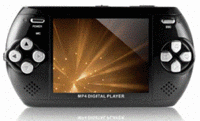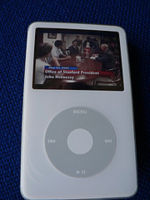MLearning:A look at educational uses of PlayStation Portable (PSP) or Portable Media Player (PMP)
Contents
Objectives
In this article we will discuss:
- Brief background to mLearning
- Features of PSP/PMP useful for delivering contents to learners
- Scenarios for using PSP/PMP as a learning and development tool
Brief background to mLearning
Without any doubt, emerging hand-held devices are bringing great transformation to mobile learning or mLearning and taking distance learning to new dimensions.
mLearning became popular with increasing access to mobile phones and the capability to send and receive SMS as a means of interacting among peers and instructors as well as community of practices. And with some more expensive mobile phones and PDAs, it is possible to record and playback audio and video.

Now, new digital media player devices, some of which are originally design as children gaming devices, are available in the market in different shapes and colors. These include iPod, Sony PlayStation Portable (PSP) and other brands of Portable Media players (PMP). These devices are very good platforms for delivering educational contents to distance learners in podcast mode. They are relatively cheap and the price will continue to fall as demand increases and more manufacturers go into production. At the moment, depending on country and location, you can get brands of PSP/PMP between US$65-120.
| PlayStation Portable (PSP) | Apple iPod | |
|---|---|---|
Features and functions of PSP/PMP useful for delivering contents to distance learners in mLearning environment
Let us take a look at the features and functions that make PSP/PMP a valuable hand-held digital device for delivering educational contents to distance learner in mLearning environments. This device is a child play thing originally design for gaming but has the capability to take distance learning to new dimension.
After a close study of the features and functions of Sony PSP and iPod. I decided to reformat some of my interactive self study modules and educational videos for PSP and iPod podcasting with particular focus on PSP.
I tested Sony PSP for its educational uses by reformatting, in podcast formats, some computer-based self-study interactive training modules that I have produced on CDs and online learning on some agricultural training topics, and some video documentaries. They all play very well. The audio quality is higher than I expected from such device.
I am impressed with the educational value and it serves as a solution to computer accessibility problem that seems to have limit some learners from using computer-based interactive learning materials, especially those who have little or no access to computers. Partial analysis of an ongoing survey among the intended users of the learning resources that I am producing, I found out that some of the intended users who claimed not to have access to computer either at the work place or home, except at an Internet Cafe, bought one brand or the other PSP/PMP for their children to play games. If that is the case, then why don't I convert some of my training modules into podcasting formats, I asked myself, that can be use on the available media players in homes. I did and even demonstrated its educational value mobile learning workshops. It was well received by all who attended my demonstration at the just concluded elearning Africa in Nairobi, Kenya.
PSP is a hand-held gaming device for children but also a valuable mobile learning tool for adults as well. It is cheap and readily available. Sony PSP costs between US$65 – 110. While other PMP brands cost less that US$65. In some cases children of some middle class save out of their pocket money to buy it.
PSP features and functions that make the device a valuable mobile learning tool include:
- Audio and video playback and recording
- E-Book reading (TXT Format files).
- High Quality Voice Digital Recording (WAV format)
- Built-in Picture/Photo Browser
See detail features and functions below:
- Friendly 3 inch Screen with 360 degree view angle 1300,000 TFT True Color Display
- Built-in Microphone & high quality stereo Speaker
- Built-in 1GB High Speed Flash Memory.
- Built in 1600mA rechargeable Li-ion battery for 4-6 hours playing continuously
- Support 256MB/512MB/1GB/2GB SD card or MMC card for game or music!
- Act as USB Flash Drive, USB 2.0 high speed transferring, Plug & Play in Windows
- Support Network Movie Playing.
- Support ASF format or other format files converted to ASF format (software included for convertion),
- Powerful A.V out (NTSC/PAL) connects to TV, A.V in (A.V recording function)
- Support MP3, MPG, MPEG I, MPEG II Converted to AMV Music Formats.
- Support ID3: The songs' titles and lyrics can be shown on screen
- Built-in Picture/Photo Browser
- Support all photos from digital camera, support EX1F 2.1
- Support JPEG format pictures downloaded from internet
Digital Camcorder/Camera Function:
- Support digital video function (ASF format/MPEG-4 or convert it to ASF format by convert software, 1- 4X times DIGITAL Zoom)
- Support digital camera/PC Camera function (1280 x 1024, 1.3Maga pixels)
- Calendar and time set function
- Support E-Book Function (TXT Format files).
- High Quality Voice Digital Recording (WAV format)
- Up to 18 hours of high quality WAV format voice recording and up to 30 hours of ACT format voice recording
Scenarios for using PSP/PMP as a learning and development tool
For supporting teachers and learners:
- Platform for playing back educational contents. I have used it to playback reformatted audios, videos and e-books in both txt format and digital picture series. And looking ahead, I could imagine a situation when instructional videos downloaded from the internet on any subject from open education resource repositories can be view over and over again on PSP. Useful to both children and adult. Instructors can prepare contents in audio or video and provide course guidelines and assignment or discussion points in txt e-book.
- It is a valuable gaming device that parents can use to support their children learning. For example, if your child has problem understanding some subject topic, mathematics, biology, physic, etc because of poor teaching strategy, you can help the child by going through some open education resources available on the internet today, download a well prepare learning materials on the subject topic, convert to podcast or e-book and let your child review it with PSP or iPod. Even when on the road or in the air, you and and your child can continue learning from downloaded materials from the internet. Many high quality open education resources are available on the internet.
- PSP/PMP can be used to support education projects in remote communities. For example, PSP/PMP manufacturer can be contacted to produce the device at discounted rates that could possibly bring the price to as low as US$20 that many more school children and students will be able to afford. And funded projects can packaged the device with some educational contents to assist teachers and remote community learners achieve a better understanding of teaching concepts and development goal.
- In remote community where there is no electricity to charge the devices, solar power charger that can charge up to 20 of such devices can be packaged with the project. Such solar chargers are available today at affordable prices from US$250.
- Farmers believe farmers - I see a situation where an NGO or extension specialist use the recording features to capture either audio only or video of a project success story telling by beneficiary farmers that can be used in a radio and/or TV program for other community awareness and development.
- Seeing is believing - I see a situation where an NGO or extension specialist loads video documentary of how farmers in other communities are able to solve a problem that is just surfacing in another community to convince the farmers. Such video can either be playback on PSP or have the PSP connected to a TV set where possible for bigger screen view.
- Picture worth more than a thousand words - I see a situation where extension specialist take the complain of a farmer with photo or video evidence of the problem taken from the farmer's field using PSP as a digital still or video camera, and relating the evidences to a specialist or expert for thorough analysis and proffer adequate solution or procedures to overcome the problem.
- Teaching aid for teachers in remote community schools – I see a situation where teachers in remote communities come to city where they could access the internet, download lesson plans in txt, video or animation of instructional illustrations to PSP and playback in classroom to promote meaningful learning even where there is no electricity in the classroom.
- Education project funding - I see a potential opportunity for donors to fund a project on testing the impact of packaging PSP with educational content for distribution to remote community school students.
- Combining PSP with mobile phone or SMS messages, a farmer can get quick feedback or response to complains.
Conclusion
Combined use of PSP and mobile phone open up a new dimension to the delivery of distance learning contents and interactions. Creativity, imagination and innovative use of PSP/PMP and mobile phone for educational purposes are boundless for mobile learning.


